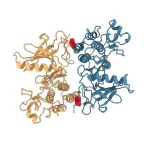(Press-News.org) Monitoring levels of DNA shed by tumors and circulating in the bloodstream could help doctors accurately assess how gastroesophageal cancers are responding to treatment, and potentially predict future prognosis, suggests a new study led by researchers at the Johns Hopkins Kimmel Cancer Center and its Bloomberg~Kimmel Institute for Cancer Immunotherapy.
The study tracked minimal residual disease (the amount of cancer left following treatment) by analyzing circulating tumor DNA (ctDNA), showing how these “liquid biopsies” can provide valuable insights into treatment outcomes over time. Absence of ctDNA was seen occurring together with specific activation of T cells that are part of the immune system’s defense to recognize and fight cancer.
“We found that the elimination of ctDNA was a good indicator of patients’ cancer-free survival,” says Valsamo “Elsa” Anagnostou, M.D., Ph.D., senior co-author of the study and associate professor of oncology and director of the thoracic oncology biorepository at Johns Hopkins. Anagnostou is also leader of Precision Oncology Analytics, co-leader of the Johns Hopkins Molecular Tumor Board and co-director of the Lung Cancer Precision Medicine Center of Excellence at Johns Hopkins. “We were gratified to see tumor shrinkage at a molecular level together with the immune system flaring up and clearing the tumor,” she says.
The findings, reported in a paper published March 19 in Nature Medicine, emerged from a clinical trial examining the safety and efficacy of two immunotherapy drugs — nivolumab and relatlimab —as part of pre-operative treatment for patients with operable esophageal and gastroesophageal junction cancer.
Patients with gastroesophageal cancer who have successfully completed the standard treatment of chemoradiotherapy followed by surgery unfortunately often see a resurgence of the disease. Therefore, researchers are looking for new immunotherapy approaches, as well as more accurate ways to assess tumors’ response to treatment.
“Immunotherapy has not yet been broadly effective for patients with gastroesophageal cancer,” says senior study co-author Vincent Lam, M.D., director of the Esophageal Cancer Research Program and an assistant professor of oncology at Johns Hopkins. “By testing new treatments in patients prior to surgery, we can make these powerful observations linking treatment-induced molecular changes with survival outcomes, thus accelerating the development of different immunotherapy approaches for our patients.”
The trial included 32 patients with operable esophageal or gastroesophageal junction cancer, who received nivolumab either alone or in combination with relatlimab prior to and during their standard treatment of chemotherapy and radiation. The drugs tested are both immune checkpoint inhibitors, which prevent cancer cells from dampening the body’s anti-cancer immune response. Researchers used liquid biopsies — tests that monitor trace levels of tumor DNA shed into the bloodstream —at different timepoints during treatment. They also measured levels of tumor-recognizing T cells and other components of tumor-specific immune responses.
About 40% of those in the nivolumab arm and 21.4% in the combination arm had a pathological complete response, meaning there was no evidence of cancer at the time of surgery. Over half of patients in both arms had a major pathological response, meaning less than 10% of cancer cells were remaining at the time of surgery.
“Historically, about two-thirds of patients treated with standard chemoradiation prior to surgery are alive after two years,” Lam says. “In our study, some 72.5% of participants had no signs of cancer and 82.6% were still living after two years. Notably, patients with undetectable ctDNA at different timepoints following immunotherapy had significantly longer cancer-free survival.”
The findings “open the door for more personalized treatment,” says lead study author Ronan Kelly, M.D., M.B.A., chief of oncology at Baylor Scott & White Health – North Texas. Kelly was at Johns Hopkins at the time of the study. “We can either de-escalate or intensify the treatment for patients who have gone through the standard protocol,” he says. “If we see ctDNA is still there, and they don’t have robust T cell response, these are the patients who may benefit most from additional treatment.”
The study adds to a growing collection of evidence showing the value of molecular readouts like ctDNA to assess response to therapy and guide future treatment plans. For example, another recent study from Anagnostou’s lab, along with a ctDNA-adaptive clinical trial led by Johns Hopkins investigators, showed that ctDNA clearance can predict the success of immunotherapy treatment in patients with advanced lung cancer.
“You can imagine that liquid biopsies may be used to capture and monitor cancer spread in the body and determine tumor regression across all types of cancers and therapies. There’s ever-growing evidence to support the use of ctDNA in the full range of the cancer care continuum,” says Anagnostou. “We think it’s the future.”
Additional study co-authors were Blair Landon, Dipika Singh, Jenna Canzoniero, Archana Balan, Russell Hales, K Ranh Voong, Richard Battafarano, Stephen Yang, Stephen Broderick, Jinny Ha, Kristen Marrone, Gavin Pereira, Nisha Rao, Aryan Borole, Katerina Karaindrou, Zineb Belcaid, James White, Suqi Ke, Eun Ji Shin, Elizabeth Thompson, Kellie Smith, Chen Hu and Josephine Feliciano of Johns Hopkins. Experts from the Allegheny Health Network Cancer Institute also contributed to the work.
The study was supported by Bristol Myers Squibb. Translational work was supported in part by the National Institutes of Health (grants CA121113, R37 CA251447), the Cancer Research Institute, Torrey Coast Foundation GEMINI CLIP Award, the Bloomberg~Kimmel Institute for Cancer Immunotherapy, the ECOG-ACRIN Thoracic Malignancies Integrated Translational Science Center grant, the Mark Foundation for Cancer Research, and the Conquer Cancer Foundation of ASCO Career Development Award.
Lam has served in a consultant/advisory role for AnHeart Therapeutics, Takeda, Bristol Myers Squibb, AstraZeneca, Merck and Seattle Genetics. Anagnostou receives research funding to The Johns Hopkins University from AstraZeneca and Personal Genome Diagnostics, has received research funding to Johns Hopkins University from Bristol Myers Squibb and Delfi Diagnostics in the past five years, is an advisory board member for AstraZeneca and NeoGenomics and receives honoraria from Foundation Medicine. She also is an inventor on several patent applications submitted by Johns Hopkins University related to cancer genomic analyses, ctDNA therapeutic response monitoring and immunogenomic features of response to immunotherapy, which have been licensed to one or more entities. Under the terms of these license agreements, the university and inventors are entitled to fees and royalty distributions. These arrangements are being managed by The Johns Hopkins University in accordance with its conflict-of-interest policies.
END
Circulating tumor DNA levels predict treatment outcomes for patients with gastroesophageal cancer treated with a novel immunotherapy combination
2024-03-19
ELSE PRESS RELEASES FROM THIS DATE:
Association between miR-492 rs2289030 G>C and susceptibility to neuroblastoma in Chinese children from Jiangsu province
2024-03-19
Neuroblastoma is a heterogeneous solid tumor that originates extracranially from neuroblasts. Previous research has demonstrated that miR-492 polymorphisms can contribute to cancer susceptibility. However, their specific involvement in susceptibility to neuroblastoma has yet to be fully clarified.
Background and objectives
Neuroblastoma is a heterogeneous solid tumor that originates extracranially from neuroblasts. Previous research has demonstrated that miR-492 polymorphisms can contribute to cancer susceptibility. However, their specific involvement in susceptibility to neuroblastoma has yet to be fully clarified.
In this study, we focused on miRNA-492, which has been reported to ...
Choosing over the counter drugs for COVID 19? It’s complicated
2024-03-19
COVID-19 illness may include symptoms such as a sore throat, fever, cough and fatigue. In January, the United States Centers for Disease Control and Prevention (CDC) issued its most recent guidelines for the use of over the counter (OTC) drugs for COVID-19. Specifically, its guidelines state that most people with COVID-19 have mild illness and can recover at home while treating symptoms with OTC medicines such as acetaminophen (Tylenol) or ibuprofen (Motrin, Advil).
Researchers from Florida Atlantic University’s Schmidt College ...
Binghamton University’s Speech and Language Pathology program receives accreditation candidacy
2024-03-19
BINGHAMTON, N.Y. -- The new Master of Science in Speech and Language Pathology (MS-SLP) program at Binghamton University’s Decker College of Nursing and Health Sciences has achieved a significant milestone toward accreditation by the Council on Academic Accreditation in Audiology and Speech-Language Pathology (CAA). The council recently awarded the program accreditation candidacy for five years, beginning Feb. 1, 2024, and running through Jan. 31, 2029.
The decision was based on a thorough review of all candidacy materials for the program, including the application, site visit report and the program’s ...
Characterizing salps as predators of marine microbes
2024-03-19
A huge fraction of global flows of carbon and other nutrients passes through marine microbes, little is known about their causes of death—information that in many cases determines where those nutrients will go. Recent work on microbial death via viral lysis and protistan predation is helping close the gap, but there remains a missing source of microbial mortality. Anne Thompson and colleagues explore the role played by salps, pelagic tunicates that feed by pumping seawater through mucous mesh nets, filtering out and capturing particles such as preferred microbes. Salps send ...
Four PPPL researchers featured in the Physics of Plasmas Early Career Collection
2024-03-19
The U.S. Department of Energy’s Princeton Plasma Physics Laboratory (PPPL) made a strong showing in this year’s Early Career Collection from the scientific journal Physics of Plasmas. The collection represents the top papers from all areas of plasma physics research authored by people who defended their dissertations less than five years before the journal article was submitted.
“The first authors of the pieces in the 2023 Early Career Collection have made a notable contribution to the field of plasma and show significant promise. I look forward to ...
Does AI help or hurt human radiologists’ performance? It depends on the doctor
2024-03-19
One of the most touted promises of medical artificial intelligence tools is their ability to augment human clinicians’ performance by helping them interpret images such as X-rays and CT scans with greater precision to make more accurate diagnoses.
But the benefits of using AI tools on image interpretation appear to vary from clinician to clinician, according to new research led by investigators at Harvard Medical School, working with colleagues at MIT and Stanford.
The study findings suggest that individual clinician differences shape the interaction between human ...
Scientists identify Achilles heel of lung cancer protein
2024-03-19
Researchers have shown for the first time that a crucial interface in a protein that drives cancer growth could act as a target for more effective treatments.
The study was led by the Science and Technology Facilities Council (STFC) Central Laser Facility (CLF) and used advanced laser imaging techniques to identify structural details of a mutated protein which help it to evade drugs that target it.
It is published (19/03/2024) in the journal, Nature Communications and lays the groundwork for future research into ...
Insulin affects the recycling of cellular power plants
2024-03-19
The hormone insulin controls many cellular processes and adapts them to the body’s current energy supply. One of the insulin-regulated processes is the quality control of cellular power plants in neurons, Angelika Harbauer and her team at the Max Planck Institute for Biological Intelligence discovered. When sufficient energy is available in the body, insulin facilitates the elimination of defective mitochondria. When energy is scarce or when the insulin signal is interrupted, mitochondrial recycling is reduced and cells continue to use their old power plants, even potentially damaged ones. The continued operation of faulty mitochondria could affect ageing ...
Brown researchers develop brain-inspired wireless system to gather data from salt-sized sensors
2024-03-19
PROVIDENCE, R.I. [Brown University] — Tiny chips may equal a big breakthrough for a team of scientists led by Brown University engineers.
Writing in Nature Electronics, the research team describes a novel approach for a wireless communication network that can efficiently transmit, receive and decode data from thousands of microelectronic chips that are each no larger than a grain of salt.
The sensor network is designed so the chips can be implanted into the body or integrated into wearable devices. Each submillimeter-sized silicon sensor mimics ...
New research highlights strong demand for data on personalized risk of preeclampsia
2024-03-19
South San Francisco, Calif. (March 19, 2024) - A new study in BMC Pregnancy and Childbirth finds that objective information about risk of preeclampsia could be key to driving patient behavior change and creates motivation among pregnant patients to follow provider recommendations on prevention, even among those who are medication-hesitant.
Key findings include:
91% of the study participants desired predictive testing for preeclampsia
94% reported they would want blood pressure monitoring at home if found to be at high risk
88% reported they would be more motivated to follow their provider’s medication recommendations if at high risk. This finding was consistent ...







